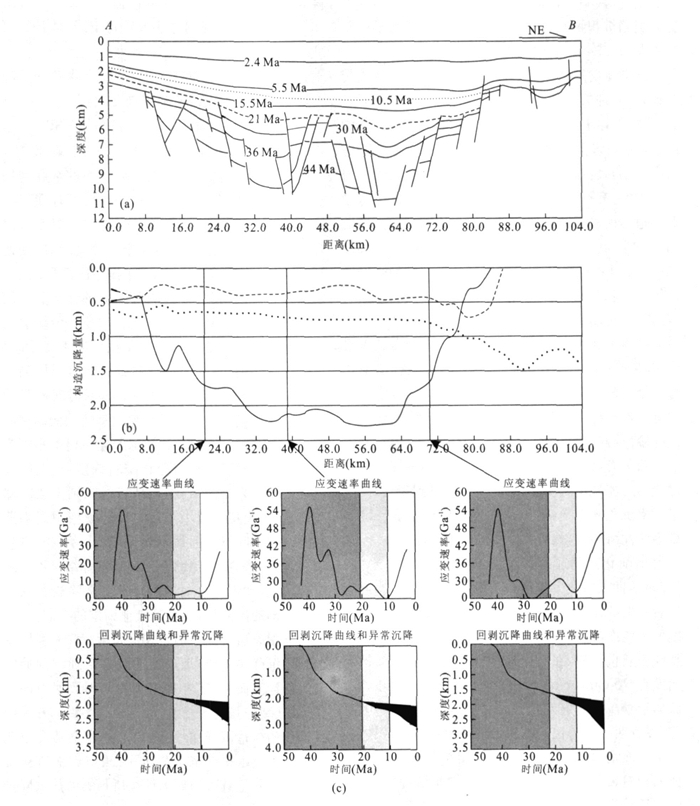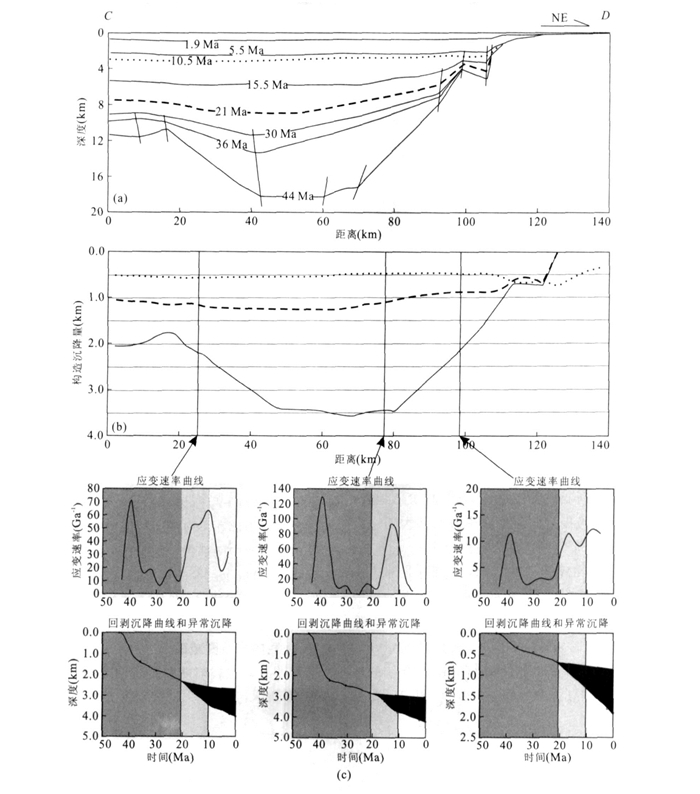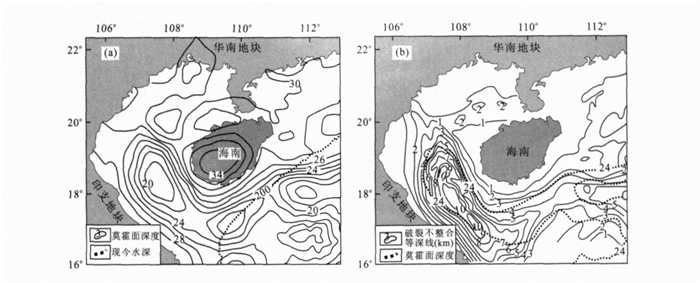Dynamic Mechanism of Anomalous Post-Rift Subsidence in the Yinggehai Basin
-
摘要: 为了理解莺歌海盆地形成与演化的动力过程, 用回剥法和应变速率反演方法对该区的钻井和地层剖面资料进行了研究.研究结果表明莺歌海盆地观测得到的裂后沉降和模拟预测的理论裂后沉降结果存在较大差异, 其中在西北部为300~500 m, 中部和东南部为900~1200 m, 其异常裂后沉降明显呈现向东南和向海方向递大的趋势.地幔对流模型预测的结果表明, 20 Ma以来南海北部边缘的动力地貌沉降量为300 m, 因此, 莺歌海盆地裂后异常沉降在300 m左右的地区可以用动力地貌沉降机理来解释, 但是盆地中部和东南部的巨厚的异常沉降远大于动力地貌沉降量, 它是自晚中新世以来盆缘断层的右旋走滑作用、裂后热回沉和动力地貌沉降共同作用的结果.Abstract: In order to understand the dynamic mechanism of formation and evolution of the Yinggehai basin, the backstripping and strain rate inversion methods are used to study the stratigraphic sections and boreholes by analyzing the relevant data.The results show a discrepancy between observed post-rift subsidence and theoretically predicted post-rift subsidence based on a multiple rift model.Our modeling results of two seismic sections show clearly that the anomalous subsidence during the post-rift stage in the northwestern part of the basin, between 300 m and 500 m, is much less than that in the middle and southeastern parts, which ranges from 900 to 1 200 m.We compare these results with those of time-dependent dynamic topography subsidence based on the global mantle flow model.The computed dynamic topography decreases by about 300 m from 20 Ma ago to the present in the northern South China Sea area.Observed anomalous subsidence within a range of less than 300 m during the post-rift stage can be interpreted as the effect of dynamic topography.However, the huge anomalous subsidence in the middle and southeastern areas may originate from a combination of the dextral strike-slip movements of marginal faults since the Late Miocene, rapid thermal subsidence after rifting and the response of dynamic topography.
-
图 2 莺歌海盆地西北部二维A-B剖面构造沉降模拟(位置参见图 1)
a.地层剖面; b.构造沉降量, 实线表示裂陷期沉降, 短横虚线代表 21~10.5 Ma的裂后沉降量, 点虚线代表 10.5 Ma以来的区域沉降量; c.3个模拟点的应变速率曲线及异常裂后沉降量, 图框中深灰色阴影带表示裂陷期, 浅灰色阴影带表示裂后沉降期, 白色带表示区域沉降期, 黑色三角带为异常裂后沉降量
Fig. 2. Two dimensional A-B section used for calculating tectonic subsidence in the northwestern Yinggehai basin and the related modeling results
图 3 莺歌海盆地中部二维C-D剖面构造沉降模拟(位置参见图 1)
a.地层剖面; b.构造沉降量, 实线表示裂陷期沉降, 短横虚线代表 21~10.5 Ma的裂后沉降量, 点虚线代表 10.5 Ma以来的区域沉降量; c.3个模拟点的应变速率曲线及异常裂后沉降量, 图框中深灰色阴影带表示裂陷期, 浅灰色阴影带表示裂后沉降期, 白色带表示区域沉降期, 黑色三角带为异常裂后沉降量
Fig. 3. Two dimensional C-D section used for calculating tectonic subsidence in the central Yinggehai basin and the related modeling results
图 4 莫霍面和破裂不整合深度对比(Xie et al., 2006)
Fig. 4. Comparison of the Moho depth (a) and isobath of the breakup uncomformities (b)
-
Allen, C. R., Gillespie, A. R., Han, Y., et al., 1984. Red River and associated faults, Yunnan Province, China: Quaternary geology, slip rates, and seismic hazard. Geological Society of America Bulletin, 95: 686-700. doi: 10.1130/0016-7606(1984)95<686:RRAAFY>2.0.CO;2 Baldwin, S., 1999. Quantifying the development of a deep sedimentary basin: The Bonaparte basin, NW Australia [Dissertation]. Cambridge University, Cambridge, 236. Briais, A., Patriat, P., Tapponnier, P., 1993. Updated interpretation of magnetic anomalies and seafloor spreading stages in the South China Sea: Implications for the Tertiary tectonics of Southeast Asia. Journal of Geophysical Research, 98 (B4): 6299-6328. doi: 10.1029/92JB02280 Burgess, P. M., Gurnis, M., Moresi, L., 1997. Formation of sequences in the cratonic interior of North America by interaction between mantle, eustatic, and stratigraphic processes. Geological Society of America Bulletin, 109 (12): 1515-1535. doi: 10.1130/0016-7606(1997)109<1515:FOSITC>2.3.CO;2 Clift, P., Lin, H., 2001. Preferential mantle lithospheric extension under the South China margin. Marine and Petroleum Geology, 18 (8): 929-945. doi: 10.1016/S0264-8172(01)00037-X Clift, P., Lin, J., Barckhausen, U. E., 2002. Evidence of low flexural rigidity and low viscosity lower continental crust during continental break-up in the South China Sea. Marine and Petroleum Geology, 19 (8): 951-970. doi: 10.1016/S0264-8172(02)00108-3 Clift, P. D., Lin, J., ODP Leg 184 Scientific Party, 2001. Patterns of extension and magmatism along the contine ntocean boundary, South China margin. In: Wilson, R. C., Whit marsh, R. B., Taylor, N., et al., eds., Non-volcanic rifting of continental margins: A comparison of evidence from land and sea. Geological Society, London, Special Publication, 187: 489-510. Fang, N. Q., Yao, B. C., Wan, L., et al., 2007. The velocity structure of the lithosphere and the origin of sedimentary basins in the South China and northern margin of the South China Sea. Earth Science—Journal of China University of Geosciences, 32 (2): 147-154 (in Chinese with English abstract). Gong, Z. S., Li, S. T., Xie, T. J., et al., 1997. Continental margin basin analysis and hydrocarbon accumulation of the northern South China Sea. Science Press, Beijing, 193-256 (in Chinese). Guo, L. Z., Zhong, Z. H., Wang L. S., et al., 2001. Regional tectonic evolution around Yinggehai basin of South China Sea. Geological Journal of China Universities, 7 (1): 1-12 (in Chinese with English abstract). Hager, B. H., O′Connell, R. J., 1981. Asimple global model of plate dynamics and mantle convection. Journal of Geophysics Research, 86 (B6): 4843-4867. doi: 10.1029/JB086iB06p04843 Hayes, D. E., Nissen, S. S., Buhl, P., et al., 1995. Throughgoing crustal faults along the northern margin of the South China Sea and their role in crustal extension. Journal of Geophysical Research, 100 (B11), 22435-22446. doi: 10.1029/95JB01867 Leloup, P. H., Lacassin, R., Tapponnier, P., et al., 1995. The Ailaoshan-Red River shear zone (Yunnan, China), Tertiary transform boundary of Indochina. Tectonophysics, 251 (1-4): 3-84. doi: 10.1016/0040-1951(95)00070-4 Li, S. T., Lin, C. S., Zhang, Q. M., et al., 1998. Dynamic process of episodic rifting in continental marginal basin and tectonic events since 10 Ma in South China Sea. Chinese Science Bulletin, 43 (8): 797-810 (in Chinese). doi: 10.1360/csb1998-43-8-797 Li, S. T., Xie, X. N., Wang, H., et al., 2004. Principle and application of sedimentary basin analysis. Higher Education Press, Beijing (in Chinese). Lin, C. S., Li, S. T., Zhang, Q. M., 1997. Lithospheric stretching, subsidence and thermal history modeling: Application to Yinggehai, Qiongdongnan and Songliao basins in East China. Journal of China University of Geosciences, 8: 83-89. Lithgow-Bertelloni, C., Gurnis, M., 1997. Cenozoic subsidence and uplift of continents from time-varying dynamic topography. Geology, 25 (8): 735-738. doi: 10.1130/0091-7613(1997)025<0735:CSAUOC>2.3.CO;2 Lü, M., Zhang, G. H., 1995. Study on depositional systems and sequence stratigraphy in the Yinggehai and Qiong-dongnan basins. Research Report of Nanhai West Corporation of China Offshore Oil, Zhanjiang (in Chinese). Müller, R. D., Lim, V. S. L., Isern, A. R., 2000. Late Tertiary tectonic subsidence on the northeast Australian passive margin: Response to dynamic topography. Marine Geology, 162 (2-4): 337-352. doi: 10.1016/S0025-3227(99)00089-4 Rangin, C., Huchon, P., Le Pichon, X., et al., 1995. Cenozoic deformation of Central and South Vietnam. Tectonophysics, 251 (1-4): 179-196. doi: 10.1016/0040-1951(95)00006-2 Ren, J. Y., Tamaki, K., Li, S. T., et al., 2002. Late Mesozoic and Cenozoic rifting and its dynamic setting in eastern China and adjacent areas. Tectonophysics, 344: 175-205. doi: 10.1016/S0040-1951(01)00271-2 Richards, M. A., Hager, B. H., 1984. Geoid anomalies in a dynamic Earth. Journal of Geophysical Research, 89: 5987-6002. doi: 10.1029/JB089iB07p05987 Ru, K., Pigott, J. D., 1986. Episodic rifting and subsidence in the South China Sea. American Association of Petroleum Geologists Bulletin, 70 (9): 1136-1155. Sclater, J. G., Christie, P. A. F., 1980. Continental stretching: An explanation of the post-Mid-Cretaceous subsidence of the central North Sea basin. Journal of Geophysical Research, 85 (B7): 3711-3739. doi: 10.1029/JB085iB07p03711 Song, X. D., Li, S. T., Li, Y. C., et al., 2004. Structure of lithospheric mantle and its implications for the evolution of major basins in China. Earth Science—Journal of China University of Geosciences, 29 (5): 531-538 (in Chinese with English abstract). Steinberger, B., Sutherland, R., O'Connell, R. J., 2004. Prediction of Emperor-Hawaii seamount locations from a revised model of global plate motion and mantle flow. Nature, 430: 167-173. doi: 10.1038/nature02660 Su, D. Q., White, N., McKenzie, D., 1989. Extension and subsidence of the Pearl River Mouth basin, northern South China Sea. Basin Research, 2: 205-222. doi: 10.1111/j.1365-2117.1989.tb00036.x Sun, Z., Zhong, Z. H., Zhou, D., 2007. The analysis and analogue modeling of the tectonic evolution and strong subsidence in the Yinggehai basin. Earth Science—Journal of China University of Geosciences, 32 (3): 347-356 (in Chinese with English abstract). Sun, Z., Zhou, D., Zhong, Z. H., et al., 2003. Experimental evidence for the dynamics of the formation of the Yinggehai basin, NW South China Sea. Tectonophysics, 372: 41-58. doi: 10.1016/S0040-1951(03)00230-0 Wheeler, P., White, N., 2000. Quest for dynamic topography: Observations from Southeast Asia. Geology, 28 (11): 963-966. doi: 10.1130/0091-7613(2000)28<963:QFDTOF>2.0.CO;2 Wheeler, P., White, N., 2002. Measuring dynamic topography: An analysis of Southeast Asia. Tectonics, 21 (5): Art. No. 1040SEP-OCT. White, N., 1993. Recovery of strain-rate variation from inversion of subsidence data. Nature, 366 (6454): 449-452. doi: 10.1038/366449a0 White, N., 1994. An inverse method for determining lithospheric strain rate variation on geological timescales. Earth and Planetary Science Letters, 122: 351-371. doi: 10.1016/0012-821X(94)90008-6 Xie, X. N., Müller, R. D., Li, S. T., et al., 2006. Origin of anomalous subsidence along the northern South China Sea margin and its relationship to dynamic topography. Marine and Petroleum Geology, 23: 745-765. doi: 10.1016/j.marpetgeo.2006.03.004 方念乔, 姚伯初, 万玲, 等, 2007. 华南和南海北部陆缘岩石圈速度结构特征与沉积盆地成因. 地球科学——中国地质大学学报, 32 (2): 147-154. https://www.cnki.com.cn/Article/CJFDTOTAL-DQKX200702000.htm 龚再升, 李思田, 谢泰俊, 等, 1997. 南海北部大陆边缘盆地分析与油气聚集. 北京: 科学出版社, 193-256. 郭令智, 钟志洪, 王良书, 等, 2001. 莺歌海盆地周边区域构造演化. 高校地质学报, 7 (1): 1-12. doi: 10.3969/j.issn.1006-7493.2001.01.001 李思田, 林畅松, 张启明, 等, 1998. 南海北部大陆边缘盆地幕式裂陷的动力过程及10 Ma以来的构造事件. 科学通报, 43 (8): 797-810. doi: 10.3321/j.issn:0023-074X.1998.08.003 李思田, 解习农, 王华, 等, 2004. 沉积盆地分析理论与应用. 北京: 高等教育出版社. 吕明, 张国华, 1995. 莺-琼盆地层序地层及沉积体系研究. 85-102-10-02. 湛江: 中国海洋石油南海西部公司. 宋晓东, 李思田, 李迎春, 等, 2004. 岩石圈地幔结构及其对中国大型盆地的演化意义. 地球科学——中国地质大学学报, 29 (5): 531-538. https://www.cnki.com.cn/Article/CJFDTOTAL-DQKX200405004.htm 孙珍, 钟志洪, 周蒂, 2007. 莺歌海盆地构造演化与强烈沉降机制的分析和模拟. 地球科学——中国地质大学学报, 32 (3): 347-356. https://www.cnki.com.cn/Article/CJFDTOTAL-DQKX200703006.htm -










 下载:
下载:




